Labor cost is undoubtedly one of the highest expenses in a restaurant, typically accounting for around 30%.
What’s more, there has been a 33% increase in labor costs for restaurant workers over the last five years.
In light of this, it’s wise to seek ways to reduce these costly expenses.
But let's be clear: this should never come at the expense of fairly compensating your staff.
However, if there are ways to trim labor costs without compromising excellent customer service, why not explore them?
Restaurant automation offers a viable solution here. So today, we'll explore how automation can effectively reduce labor costs, allowing you to consider its benefits for your restaurant.
Let's jump right in.
Table of contents
- Automates Simple Tasks
- Reduces the Need for Employee Training
- Reduces Labor Hours
- Optimizes Staffing Levels
- Reduces Human Error
- Conclusion
Automates Simple Tasks
Tasks like taking reservations, making reminder calls to guests, and jotting down orders might seem straightforward.
However, in the hustle and bustle of restaurants, they consume a significant amount of time and resources.
That’s where restaurant automation tools step in, taking over these routine, time-consuming tasks and freeing up your staff’s time for more important things.
Let’s take the example of managing reservations.
If you’ve ever handled reservations through phone calls or emails, you know how much time it can eat up.
In some cases, restaurants even hire dedicated staff for this purpose, which can be pretty costly.
But here’s where restaurant automation can make a difference.
Restaurant reservation software, like our very own Tablein, takes this burden off your hands.
This software brings automation by efficiently managing bookings directly from your website, social media profiles or even Google, sparing you the need for a dedicated staff member to answer reservation calls.
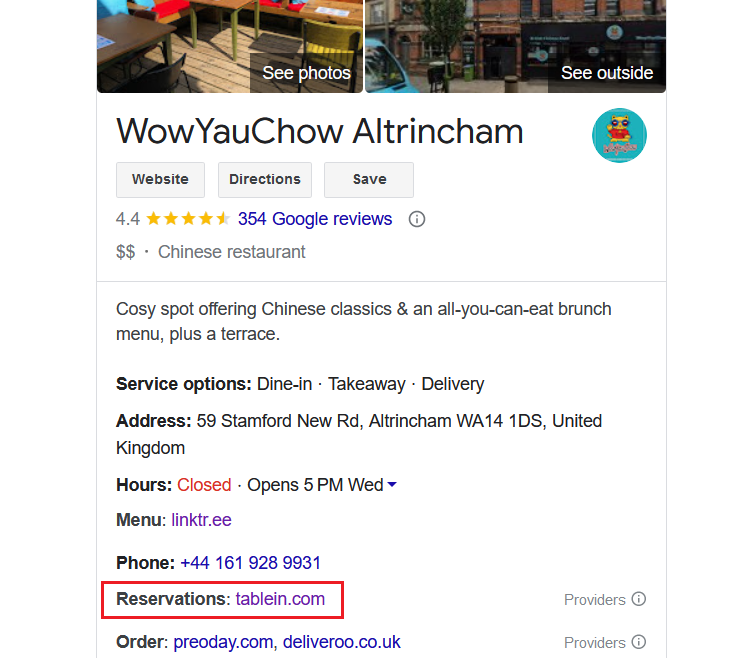
Source: WowYauChow on Google
What’s more, Tablein can also send reservation SMS or email reminders to your guests, sparing your staff from making countless reminder calls or crafting and sending numerous emails on their own.
Why is this important?
Well, the tasks that restaurant reservation software can handle could reduce the need for an additional person on your payroll.
However, reservation software is just the beginning.
Consider the self-ordering kiosks you’ve encountered in fast-food restaurants like McDonald’s.
These kiosks are prime examples of how automation simplifies the ordering process and reduces labor costs.
When customers place orders independently through these tools, the demand for servers decreases because they are no longer required to take orders at each table.
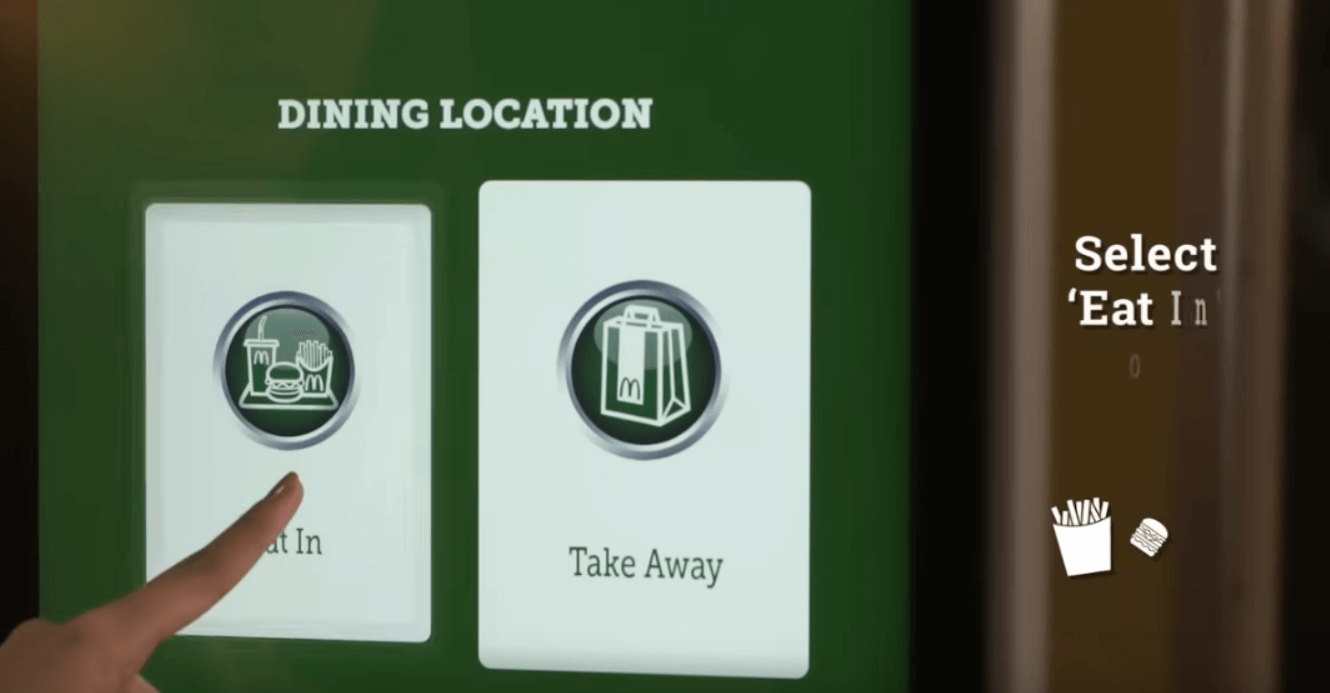
Source: McDonald’s Singapore on YouTube
And if you still want to maintain a connection between your patrons and your staff while reducing labor costs, you can implement pay-at-table technology where servers can use iPads to take orders and process payments directly at the table.
For example, Mr Miyagi, a Japanese restaurant from Windsor, Australia, reduced labor costs by 30% by implementing this technology.
We implemented pay-at-table and now our servers have iPads that they take to process your order tableside. And that’s reduced our labor costs by about 30%. If you order a glass of wine, we hit two buttons and that wine is on the way to you. It freed everything up so much in terms of time and efficiency and ability to spend time with the guest, which is the most important thing for us.
As you can see, tools like restaurant reservations software, self-ordering kiosks, and pay-at-table systems automate seemingly simple but often labor-intensive tasks.
When you use these tools to handle reservations, orders and payments, you can achieve the same level of service with fewer staff members, resulting in a significant reduction in labor costs.
Reduces the Need for Employee Training
Investing in restaurant automation systems provides a practical solution to minimize the ongoing expenses linked to employee training. Let's explore the reasons why this is the case.
When you onboard new staff members, you'll inevitably have to invest both time and resources in their training, incurring financial costs and consuming valuable time.
However, in the restaurant industry, where the average employment period is just 56 days, you find yourself stuck in a constant cycle of training, repeating the process every two months.
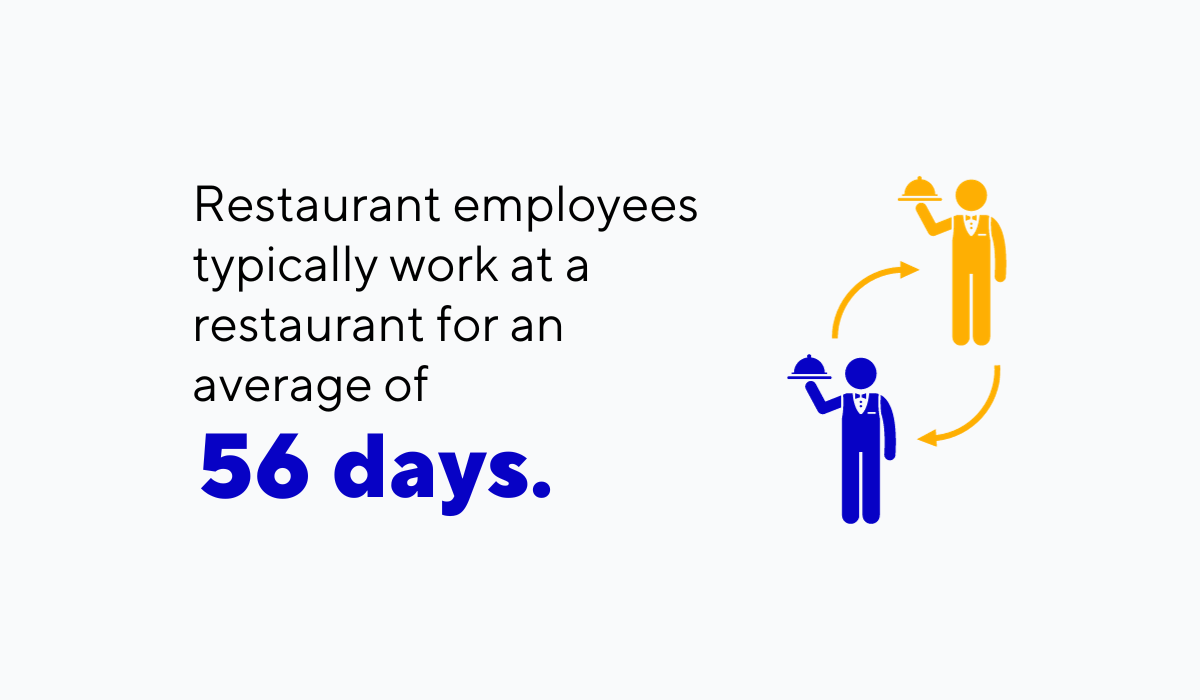
Illustration: Tablein / Data: Opus
This continuous turnover of employees has led restaurants to turn to automation as a solution, and it's no surprise.
Restaurant automation tools take over certain tasks, as we already explored, leaving restaurant owners and managers with less things to teach their new employees.
Your new team member now doesn’t have to learn, say, 10 new things, but 4.
Consequently, their ramp up period will be shortened and they will be productive much more quickly.
Furthermore, teaching new staff on how to use restaurant software is often self-serving as these automation tools are often user-friendly and intuitive.
This means you don't have to dedicate extensive time to lengthy training sessions for your employees (or yourself).
For instance, if the reservation software you choose features a user-friendly interface, like the one described below, your staff members can easily navigate the system, even if they're not tech-savvy.

Source: Tablein
This can significantly reduce the expenses that you would otherwise have to allocate to training employees on how to use the new tool.
In a nutshell, restaurant automation calls for less training overall as they take over certain aspects of work, plus they require minimal training themselves.
These factors reduce the financial burden associated with training, which is even more critical for an industry known for its high employee turnover.
Reduces Labor Hours
One of the great benefits of restaurant automation is its ability to cut labor hours and, as a result, labor costs.
By automating tasks like taking orders, managing reservations, processing payments, and keeping track of inventory, these operations become more efficient and require less time.
Take order-taking, for example. In the past, order-taking required waitstaff to visit each table, write down orders, and "walk" them to the kitchen.
However, with automation, customers can easily place their orders using user-friendly interfaces like the self-ordering kiosks we mentioned above or even mobile apps.
This significantly reduces the need for as many waitstaff to handle orders, allowing the restaurant to serve more customers with the same or even fewer employees.
Another tool that can save you many labor hours is automated inventory systems.
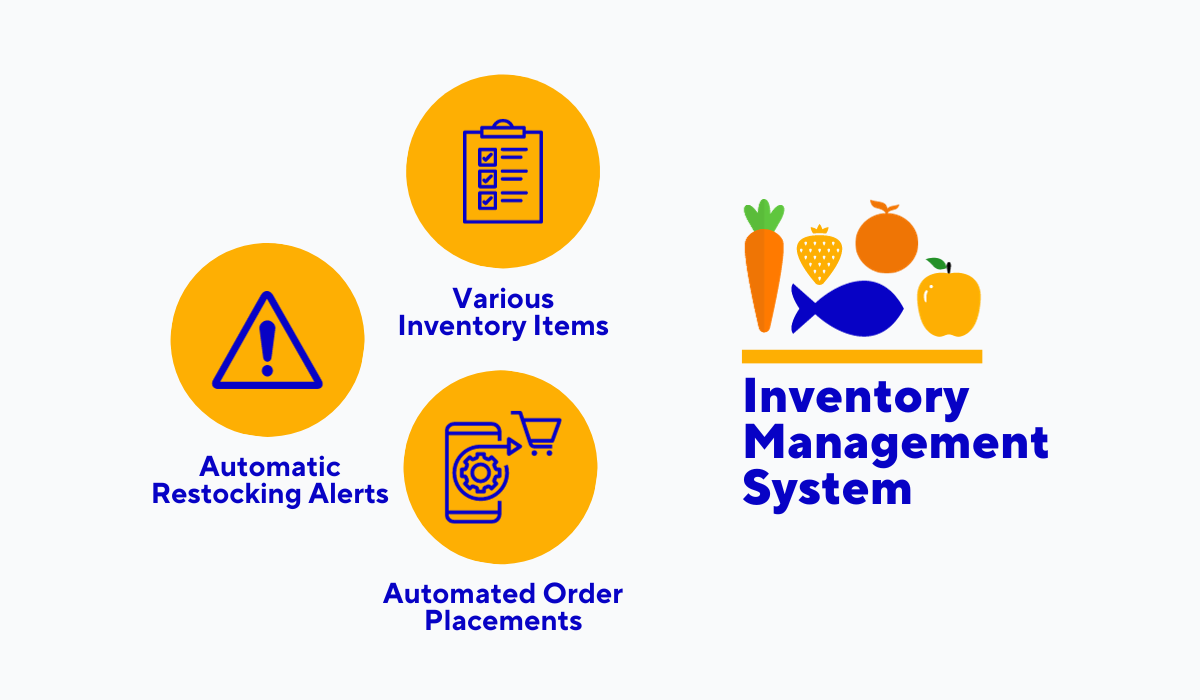
Source: Tablein
These systems carefully watch stock levels, predict restocking needs, and even automatically place orders.
This eliminates the need for manual stock counting and order entries, letting your staff focus on other tasks and, in turn, saving labor hours.
Moreover, for restaurants that receive numerous delivery orders over the phone, replacing human staff who answer calls with a voice-based AI system or an app can be a game-changer for saving labor hours.
According to Medium, a pizza restaurant, on average, spends about $2,000 monthly on the human cost of handling phone orders.
These costs are related to the time and resources required to manage phone orders, which can put additional financial pressure on the restaurant.
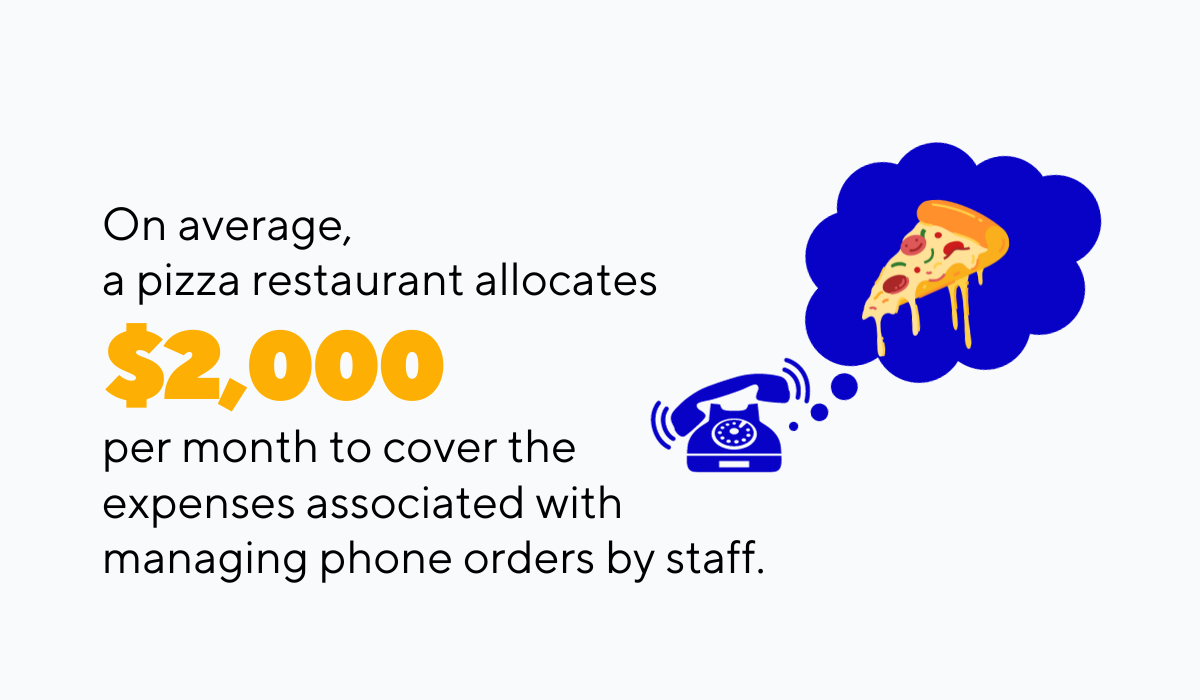
Illustration: Tablein / Data: Medium
As technology evolves, AI bots can handle order processing much faster, letting multiple customers place orders at the same time.
And according to this Wall Street Journal article, these AI bots are pretty good at additional things, like following the upselling script and analyzing customer data.
So, when you automate order taking, you're not just cutting down on labor hours and costs.
You're also getting valuable customer data and chances to upsell, which can boost your sales.
From making inventory management more straightforward to speeding up order processes without needing lots of wait staff and using modern technology like AI for order taking, it's clear that automation brings efficiency and saves you the cost of many labor hours.
Optimizes Staffing Levels
You know, one common challenge restaurants face is the tendency to overstaff during slow nights. It's an all too familiar scenario that often results in unnecessary expenses.
But here's where automation can help.
Take employee scheduling, for example.
By automating this process, you can finely adjust your staffing levels. This ensures you won't find yourself overstaffed during slow periods, which translates into significant savings on labor costs.
Just ask Joe Costanzo, Sr., co-founder and owner of RevoltTek in Monticello, Florida, and a former restaurant owner.
He's a big believer that integrating payroll and scheduling into your POS system is the solution to this age-old problem.
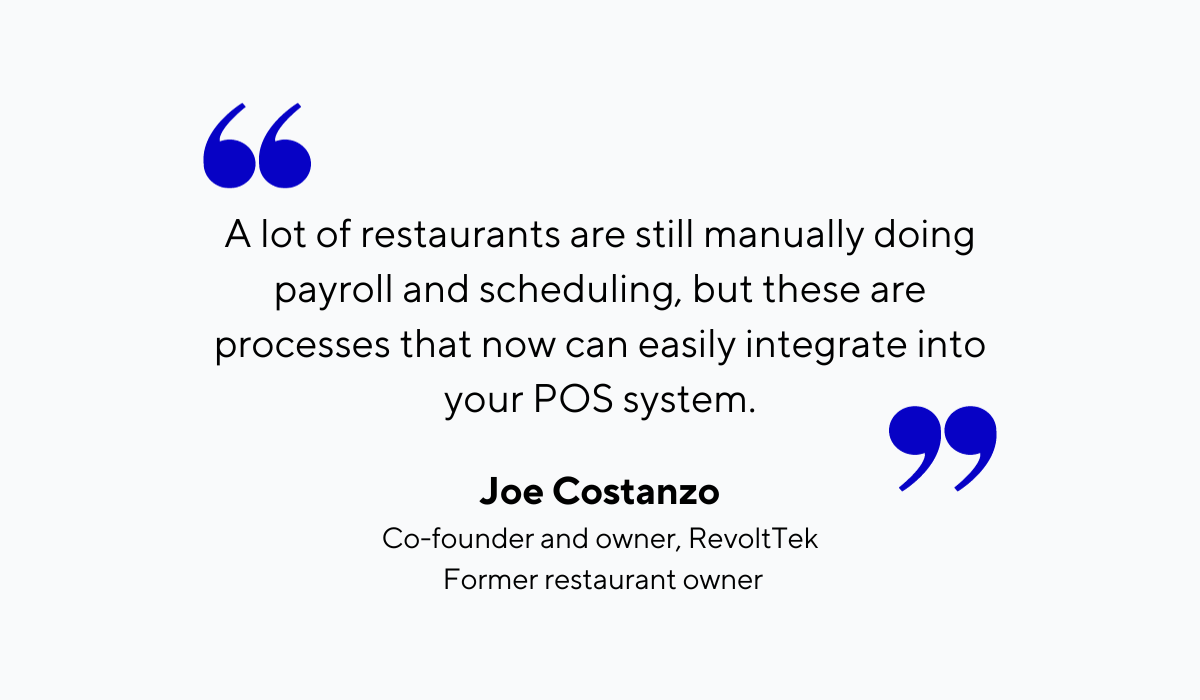
Illustration: Tablein / Data: National Restaurant Association
Let's explore how.
Firstly, POS systems can track sales data and customer traffic patterns over time.
This insightful data aids in identifying peak hours and quieter periods, allowing for precise staffing adjustments to meet demand and reduce costs during less busy times.
Moreover, through historical data analysis, a POS system can also provide forecasts for future sales, resulting in more accurate staff scheduling.
This means no more overstaffing, which can be costly, or understaffing, which can lead to compromised customer service.
Another tool for effective staffing management is reservation software.
When you take reservations, you know the exact number of patrons arriving in advance, and you can tailor your staffing schedules accordingly.
Consider Tom Hut, a small restaurant with European cuisine from Australia that uses reservation numbers to schedule staff and the amount of food they need.
We can predict in advance how many guests will visit our restaurant and then determine our food and staffing requirements.
This approach to staff scheduling has improved their planning, eliminated overstaffing, and reduced food wastage.
As you can see, with restaurant automation tools like POS systems and reservation software, you can fine-tune your staffing levels.
This ensures you're not overstaffed and throwing money down the drain when it's not needed.
Reduces Human Error
Mistakes can happen in any restaurant task, and that's perfectly normal.
But when those errors keep popping up, they can hit you in the wallet.
In fact, Medium reports that, on average, human errors cost around $30 per order and add up to a whopping $9,000 every month. Ouch.
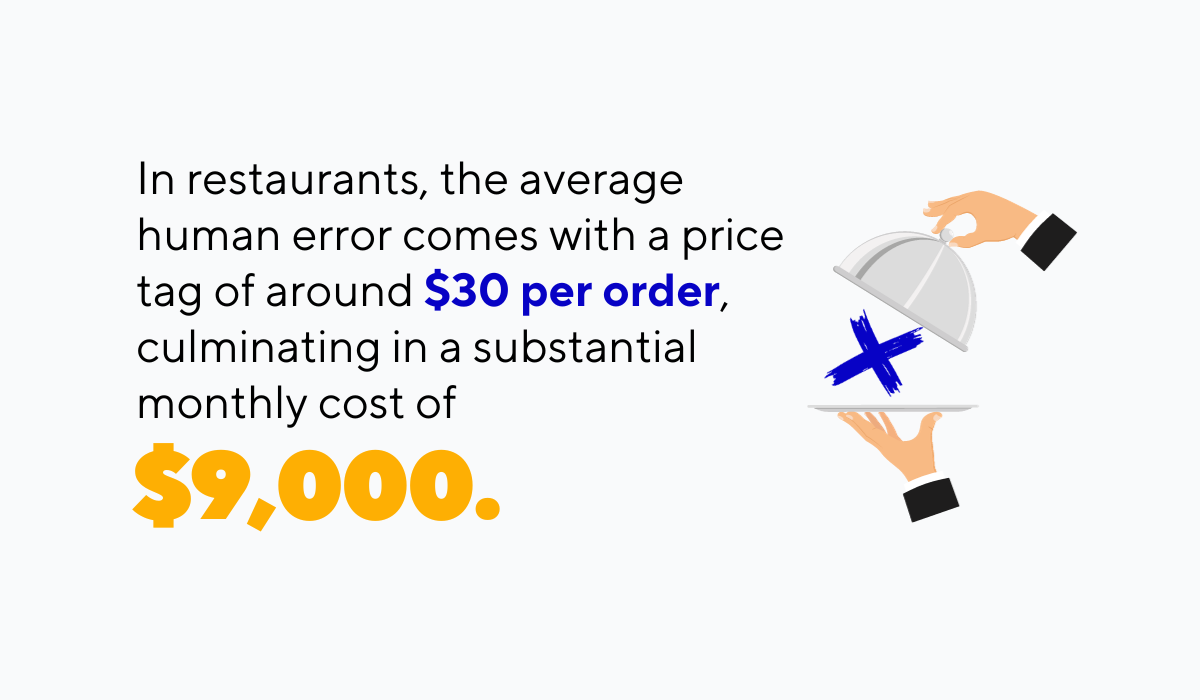
Illustration: Tablein / Data: Medium
Think about it—mishearing reservation details, not writing them down correctly, or making a slip when taking customer orders can all affect customer satisfaction.
So, it's in your best interest to avoid these costly hiccups caused by human errors.
That's where restaurant automation tools like reservation software, kitchen display systems, and digital order entry systems come to your rescue.
They're the antidote to these issues.
Here's how they work their magic.
When a customer places an order, it's instantly and accurately transmitted to the kitchen through the digital order system.
No more scribbling orders on paper, which can be prone to human error, misinterpretation, or oversights.
The kitchen display system takes things up a notch.
It ensures that the orders are presented visually to your kitchen staff, so there's no room for confusion or miscommunication.
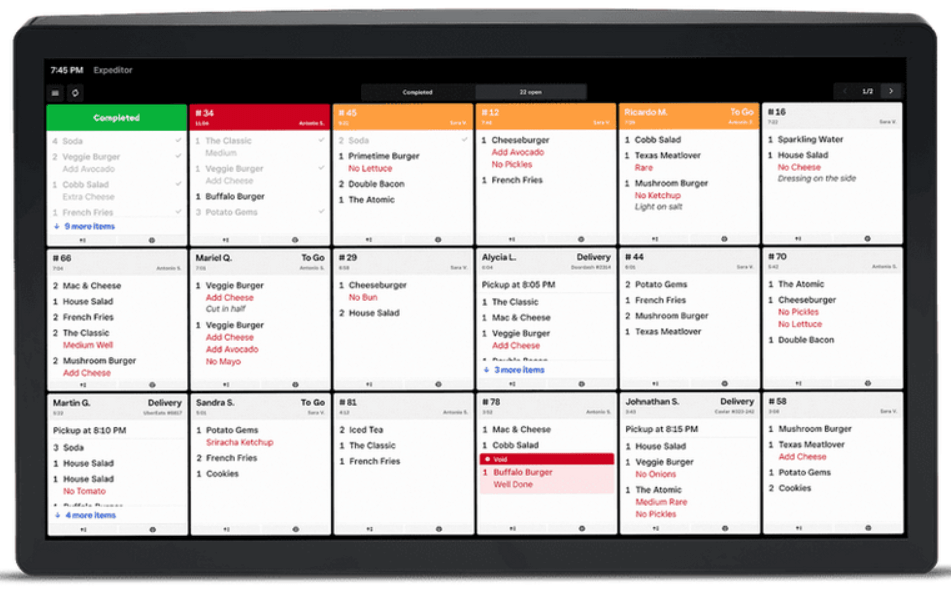
Source: Merchant Maverick
The exact instructions are right there, reducing the chances of mistakes in food preparation.
This not only ensures order accuracy but also minimizes the risk of serving the wrong dish to a customer.
And why does this matter?
Well, first of all, fewer mistakes mean less wasted food and happier customers.
Plus, every human error in a restaurant has to be fixed—and that takes time and costs money.
So, when you minimize human mistakes, your staff also spend less time fixing them, which would otherwise cost you extra in labor and time.
Conclusion
So, there you have it—your guide to the many ways in which restaurant automation can be your ally in reducing labor costs.
From streamlining tasks and preventing errors, to optimizing staffing schedules and minimizing employee training, automation leads to significant cost savings on your employee-related expenses.
In an industry where labor costs are steadily on the rise, automation tools are rapidly becoming the norm if you want to stay competitive and thrive in the ever-evolving restaurant landscape.
Now is the time to embrace automation, cut labor costs, and watch your restaurant prosper.
Get a 30-day Exclusive Trial
As a Tablein blog reader, you’re eligible for an exclusive 30-day free trial to experience our simple reservation solution for your restaurant.
Enter your business email, and we’ll send you all the steps needed to create your account.
Share this
You may also like

Charging Restaurant No-Show Fees: Pros and Cons

The Do's and Don'ts of Restaurant Reservation Confirmation Emails
